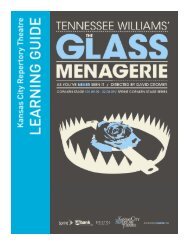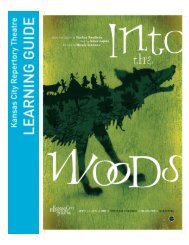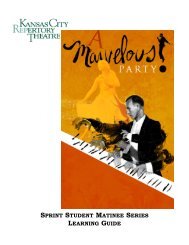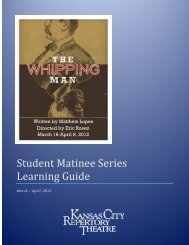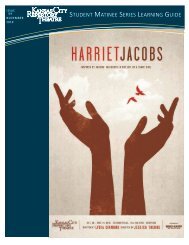A Christmas Carol - The Kansas City Repertory Theatre
A Christmas Carol - The Kansas City Repertory Theatre
A Christmas Carol - The Kansas City Repertory Theatre
You also want an ePaper? Increase the reach of your titles
YUMPU automatically turns print PDFs into web optimized ePapers that Google loves.
Pairs<br />
<strong>The</strong> chart to the right lists the average weekly expenditures<br />
for a typical family in Victorian England. Using this chart and<br />
the information regarding the Cratchit family income, have<br />
students work together in pairs to help the Cratchit family<br />
make ends meet. Have each pair answer the following<br />
questions:<br />
Including Peter’s potential income, what was the total<br />
weekly income of the Cratchit family?<br />
What is the difference between the Cratchit family<br />
income and the average weekly expenditures in 1888?<br />
Which items on the list could be considered wants?<br />
Which are considered needs?<br />
Given Tiny Tim’s condition, is the listed amount for<br />
medical attendance sufficient? If not, how much should<br />
it be increased?<br />
Which items could be omitted due to budgetary<br />
reasons?<br />
Provide reasons for why specific items were cut and how<br />
the family could make do without them.<br />
Should savings/charity be omitted? Why or why not?<br />
Extension<br />
Compare and contrast the weekly spending of the Cratchit<br />
family with your own family.<br />
Note that in the weekly expenditures for a Victorian family<br />
there is no listing for toys, games, entertainment or<br />
eating in restaurants. How is this different today? How<br />
much of today’s weekly expenditures are spent on<br />
these items? Are those items/activities “needs” or<br />
“wants”?<br />
**Remember, drinking water in Victorian<br />
England was usually contaminated—and a good<br />
way to get cholera. Drinking tea, which requires<br />
the boiling of water, significantly cut the<br />
incidence of some water‐borne diseases. Alcohol<br />
also killed the bacteria, which is why the drinking<br />
of beer and wine became so common‐place in<br />
Victorian times.<br />
Average Weekly Expenditures 1888*<br />
Item Amount<br />
Rent 5 shillings, 6 pence<br />
Meat 4 shillings<br />
Bread (10 loaves) 2 shillings, 3 pence<br />
Flour 2 shillings<br />
Vegetables<br />
(18 pounds)<br />
1 shilling, 4 pence<br />
Butter 1 shilling<br />
Fruit 1 shilling, 6 pence<br />
Milk 10 pence<br />
Tea 1 shilling<br />
Cocoa 6 pence<br />
Sugar 10 pence<br />
Soap 6 pence<br />
Starch 1 pence<br />
Candles 1 pence<br />
Kerosene 3 pence<br />
Coal 1 shilling, 3 pence<br />
Beer** 10 pence<br />
Boots (for whole<br />
family)<br />
1 shilling, 8 pence<br />
Clothes (for the<br />
man)<br />
1 shilling<br />
Clothes (for wife<br />
and children)<br />
2 shillings<br />
School Fees 4 pence<br />
Savings/Charity 1 shilling, 6 pence<br />
Medical<br />
Attendance<br />
(wife and children)<br />
3 pence<br />
Total 30 shillings,<br />
6 pence<br />
Compiled by Richard Patterson from an article<br />
entitled Life on a Guinea a Week in <strong>The</strong> Nineteenth<br />
Century (1888), p. 464.<br />
For more lesson plans dealing with earning, saving and spending<br />
download the Yes, You Can curriculum at:<br />
www.yesyoucanonline.info. Yes, You Can is sponsored by<br />
American Century Services Corporation.<br />
A <strong>Christmas</strong> <strong>Carol</strong>: Learning Guide Page 33



